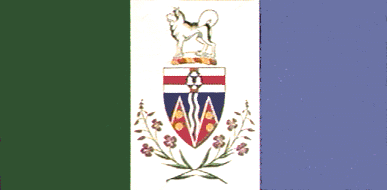|
|
|
The Yukon |
 |
|
The LandThe Yukon Territory in Canada's northwest covers 483 450 km2. The perimeters of this mountainous territory form a rough triangle bordered on the south by British Columbia, on the west by the U.S. state of Alaska and on the east by the Northwest Territories. The northern tip of the triangle meets the chilly waters of the Beaufort Sea. Mount Logan, Canada's highest peak at 6 050 metres, is located in southwestern Yukon. The Yukon can be divided into two broad geographical regions: taiga and tundra. Taiga is the boreal forest belt that circles the world in the subarctic zone, including most of the Yukon. Tundra is the vast, rocky plain in the Arctic regions, where the extreme climate has stunted vegetation. The Yukon has a subarctic climate. The high altitude of much of the territory and the semi-arid climate provide relatively warm summers with temperatures frequently reaching 25°C or more during the long summer days. In winter the temperature ranges between plus 4 and minus 50°C in the south and slightly colder farther north. Above the Arctic Circle (latitude 66° north), the Yukon is known as "the land of the midnight sun" because for three months in summer, sunlight is almost continuous. In winter, however, darkness sets in, and the light of day is not seen for a quarter of the year. The HistoryThe name Yukon was first used in 1846 by the Hudson's Bay Company trader, John Bell. He called it "Yucon," derived from the Loucheux word "Yuchoo," meaning the greatest river. The Yukon River is the fifth-longest in North America. The Yukon was the first area in Canada to be settled by people. Anthropologists believe the ancestors of today's Aboriginal peoples may have inhabited the Yukon 10 000 to 25 000 years ago when they migrated from Asia across a Bering Sea land bridge. The first modern European visitors were Russian explorers who travelled along the coast in the 18th century and traded with the area's Aboriginal peoples. Sir John Franklin anchored off the Yukon's Arctic coastline in 1825, and the Hudson's Bay Company moved into the interior in the 1840s. U.S. traders arrived after the 1867 Russian sale of Alaska to the United States. With the discovery of gold near Dawson City in 1896, the Klondike became one of the most populous regions in northwestern Canada. The sudden increase in population during the Klondike gold rush prompted the federal government to give the Yukon more control over its affairs. In 1898, the Yukon Territory was officially established to ensure Canadian jurisdiction; the Yukon Act provided for a commissioner and an elected legislative assembly. Some 40 years later, during the Second World War, the United States built the Alaska Highway, creating a new overland transportation route. In 1979, the Canadian government opened the Dempster Highway, Canada's first all-weather road to cross the Arctic Circle. As a territory, the Yukon does not have full provincial status, although it achieved a style of government similar to that of the provinces in 1979. The Canadian government retains administrative control over water, land and forestry and the development of all non-renewable resources (i.e. minerals, oil and gas). The 1970s saw the emergence of the Yukon land claims negotiations. In 1993, the Council for Yukon Indians, the Government of Canada and the Yukon Territorial Government signed an Umbrella Final Agreement that sets out the terms for final land claim settlements in the Territory. Final land claim agreements were also reached with the Vuntut Gwich'in First Nation, the Champagne and Aishihik First Nation, the Teslin Tlingit Council and the First Nation of Nacho Nyak Dun. These agreements contribute to certainty of land title, and benefits include cash, land and participation on wildlife and other management boards. In addition to their land claim settlements, the four First Nations also negotiated self-government agreements that give them more control over land use on settlement lands and greater authority in areas such as language, health care, social services and education. The PeopleThe Yukon's vast interior forests were occupied by the Athapaskans, whose cultural and linguistic traditions go back more than 1 000 years. Today, there are six distinct groups of Athapaskan Aboriginal peoples: Kutchin, Han, Tutchone, Inland Tlingit, Kaska and Tagish. At present, approximately 30 700 people live in the Yukon; 21 percent of the population is Aboriginal. Over 70 percent of the population lives in Whitehorse, Yukon's capital city. The EconomyMining, the Yukon's largest industry, accounts for more than 30 percent of the economy. Tourism, offering a wilderness experience in a unique and relatively unspoiled environment, provides a further base for jobs and services. Efforts have recently been made to promote other sectors, such as the forest industry. The fur trade continues to be important to the Aboriginal peoples of the Yukon. A small fishing industry operates in Dawson City to export salmon, and other commercial fisheries supply local consumers. Agriculture - expensive by North American standards - is a small but expanding industry. Although growth of the agricultural industry is limited by climate and the availability of productive land, new research programs hold promise for the future. Back |
|
| Source: Communication Canada | |
| Related Sites: Government of Yukon |
|
|
|
|
| Top Home |